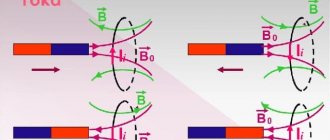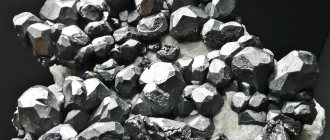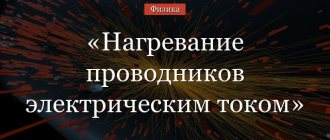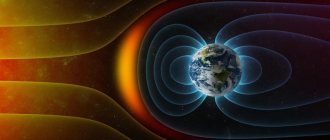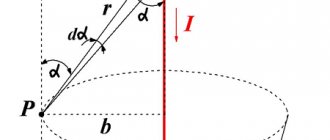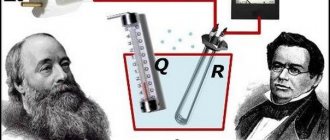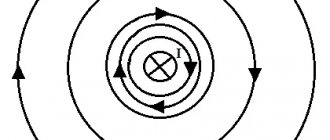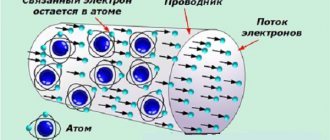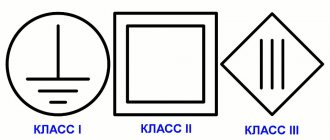Content
In the electrical phenomena we examined, we constantly observed the movement of electric charges. From mechanics you know that if there is any movement, then work is done.
What kind of work is done when electric charges move? Light bulbs in our houses and apartments, all the electrical appliances that we use every day - all this is a consequence of the work done by the electric field to move charges.
The next logical question immediately arises. How do these charges move? What makes them move? You have all heard about electric current , but have not yet looked inside this phenomenon using the tools of physics.
In this lesson you will learn what exactly is called electric current and how it is obtained.
Direction of electric current
It is necessary to understand that electric current does not cause every movement of charged particles. Under the influence of heat, electrons also begin to move, but their movement is chaotic and has no specific direction. If you add an electric field to the thermal effect on the conductor, then the electrons will begin to move with a certain direction.
The direction of movement of particles forming an electric current depends on their charge:
- positive ones move from “plus” to “minus”;
- negative - from “minus” to “plus”.
Counter movement of particles is observed in electrolytic solutions and gases. Therefore, it is extremely important to determine exactly what the current direction of the current in the circuit is. As a result, it was decided that the movement of positive particles is the direction of electric current . However, this statement does not coincide with reality when we talk about metal conductors.
The fact is that charge transfer in them occurs due to the movement of negatively charged electrons. At the same time, it is known for sure that they move from the minus to the positive pole. In this case, we have to consider the direction of the current to be opposite to the movement of charged particles.
Despite some inconvenience, this rule clearly states what is taken to be the direction of electric current and where it flows.
Electricity
The word “ current ” itself implies movement .
Some bodies (conductors) have free electrons that can carry electrical charge. This charge will be negative, because that’s exactly what electrons have.
Are there any other particles in bodies that can carry a charge? It turns out that there is.
If ordinary atoms are electrically neutral, then ions have some charge. It can be both negative and positive. These particles are larger than electrons, but can also carry electrical charge.
This means that electrons or ions can somehow move in conductors. This is where the definition of electric current follows (Figure 1).
Electric current is the ordered (directed) movement of charged particles.
Figure 1. Movement of charged particles in conductors
Please note that this movement is directed and not random. When we say that a current flows through the body, we mean a certain direction. We will talk about what this direction is in a separate lesson.
On the nature of electric current and the basics of electrical engineering
In this short article I will try to explain the basics of electrical engineering. For those who don’t understand where the electricity comes from, but it seems indecent to ask.
1. What is electric current. “The chief engineer turned the switch, and the electric current ran faster and faster through the wires” (c)
1.1 A couple of general words on the physics of the issue Electric current is the movement of charged particles. Of the charged particles, we have electrons and some ions. Ions are atoms that have lost or gained one or more electrons and therefore have lost electrical neutrality and have acquired an electrical charge. This is how the atom is electrically neutral - the charge of the positively charged nucleus is compensated by the charge of the electron shell. Ions usually carry charge in electrolytes; in metal wires, the carriers are electrons. Metals conduct current well because some electrons can jump from one atom to another. In non-conducting materials, electrons are tied to their atom and cannot move. (Let me remind you that this article is an explanation of physics at a glance! For more information, search for “electronic conductivity theory”).
We will consider the current in metal conductors, which is created by electrons. An analogy can be drawn between electrons in a conductor and liquid in a water pipe. (At the initial stage, electricity was considered a special liquid.) Just as water does not pour out through the walls of a pipe, electrons cannot leave the conductor, because the positively charged nuclei of atoms will attract them back. Electrons can only move inside a conductor.
1.2 Creation of electric current. But current will not simply arise in the conductor. It's like pouring water into a piece of pipe and sealing it at both ends. The water won't flow anywhere. In a piece of conductor, electrons also cannot move in one direction. If the electrons for some reason move to the right, then an uncompensated positive charge will appear on the left, which will pull them back. Therefore, electrons can only jump from one atom to another and back. But if the pipe is rolled into a ring, then water can already flow along the pipe if it is somehow forced to move. Likewise, the ends of a conductor can be connected to each other, and then electrons can move along the conductor if forced. If the ends of the conductor are connected to each other, then a closed circuit is obtained. Direct current can only flow in a closed circuit. If the circuit is open, then no current flows. A pump is used to force water to flow through the pipe. In the electrical circuit, the role of the pump will be played by the battery. The battery pushes electrons through a conductor and thereby creates an electric current. Scientifically, a battery is called a generator. This is what electrical engineering calls a pump for creating electric current.
There are two types of generators - voltage generator and current generator. This is a fundamental thing in fact, pay attention! See picture below
Fig. 1. Voltage generator of magnitude U Fig. 2. Current generator of magnitude I
The top picture shows a voltage generator, the bottom picture shows a current generator. The voltage generator pump creates a constant pressure, the current generator pump creates a constant flow. The upper circuit is open and the lower circuit is closed. Let's consider what properties a voltage generator has. Let's imagine the following chain
Fig 3. Voltage generator of value U with load R1
In terms of a plumbing analogy, a generator is a pump that creates constant pressure, switch SW1 is a valve that opens/closes a pipe, resistance R1 is a tap/valve that is slightly open. This fender can be covered - the resistance will increase and the water flow will decrease. You can open it more - the resistance will decrease, the water flow will increase. Everything seems to be intuitive. Now imagine that we open the tap more and more. Then the flow of water will increase and increase. In this case, the voltage generator, by definition, maintains the voltage (pressure) constant, regardless of the flow rate! If the tap is opened completely and the resistance becomes 0, then the flow becomes equal to infinity. In this case, the generator will still produce a voltage equal to U! Of course, all this happens in an ideal model, when the generator power is infinite. Real generators (batteries or accumulators) roughly correspond to this model over a certain range of voltages and currents.
Let us now consider a circuit with a current generator.
Fig 4. Current generator of magnitude I with load R2
What does a current generator do? He drives current! He is told to drive a current of magnitude I, and he drives it, regardless of the amount of resistance (how open the tap is). If the tap is fully open, the current will be equal to I. The voltage (pressure) will be equal. If the tap is completely closed, the current will still be equal to I! But in this case, the voltage (pressure) will be equal to infinity. Again in the model. From these considerations, the fundamental law of electrical engineering—Ohm’s Law—follows intuitively. ("From the red line. Underline" (c))
2. Ohm's law.
First from the point of view of the voltage generator
If voltage U is applied to resistance R, then current I =U/R will flow through the resistance. Now from the point of view of the current generator
If current I is passed through resistance R, then a voltage drop U=I*R will occur across the resistance
Somehow you need to realize this moment. These two formulations are completely equivalent and their application depends only on which generator is being considered. You can, of course, also write R=U/I. Something like - if a voltage U is applied to a section of a circuit, and a current I passes through this section, then the circuit has a resistance R. Further, it would be good to consider options for circuits with parallel or series connection of resistors, but there is reluctance. These are purely technical points. Something like
Fig 5. Series connection of resistors
A current of magnitude I passes through this circuit of series-connected resistors R1 and R2. What voltage drop will be across each resistor U1 and U2? Use Ohm's law and that's it! This circuit, by the way, has a current generator, since the input variable here is current. Well, that is, there may not be a current generator itself, it’s just that the current in the circuit is known and is considered constant and equal to I. Therefore, it is as if this current is driven by the current generator. They also say “voltage drop across a resistor”, because the generator “produces” voltage (pressure), and after each resistor the voltage will decrease, drop across this resistor by the amount U=I*R.
Although we will still consider a couple of important practical cases.
1. The most important scheme. The most important circuit that an electronics engineer will deal with constantly throughout his life is the voltage divider. ("From the red line. Underline" (c))
3. Voltage divider The circuit looks like this.
Figure 6. Voltage divider
A voltage divider consists of two resistors connected in series with each other.
By the way, a resistor is an electronic component (part) that provides electrical resistance of a certain value. It is also (the part) often called resistance. It turns out to be a bit of a tautology - resistance has a resistance R. Therefore, for parts it is better to use the name resistor. A resistor with a resistance of 1 kiloohm, for example.
So here it is. What does this circuit do? Two series resistors have some equivalent resistance, let's call it R12. Current I passes through the circuit, from the plus of the generator to the minus through resistor R1 and through resistor R2. In this case, voltage U1=I*R1 drops across resistor R1, and voltage U2=I*R2 drops across resistor R2. According to Ohm's law. Voltage U=U1+U2, as can be seen from the diagram. Thus U=I*R1+I*R2=I*(R1+R2). That is, the equivalent resistance of series-connected resistors is equal to the sum of their resistances. Expression for current I=U/(R1+R2) Let us now find what the voltage U2 is equal to. U2=I*R2= U* R2/(R1+R2).
An example of a picture from the Internet. If the resistors are equal, then the input voltage Uвx is divided in half.
The second important case is taking into account the output resistance of the source (generator) and the input resistance of the receiver (the circuit to which the generator is connected)
Figure 7. Output impedance of the source and input impedance of the receiver.
An ideal voltage generator has zero output resistance, that is, with zero external circuit resistance, the current value will be equal to infinity ∝. A real voltage generator cannot provide infinite current. Therefore, when the external circuit is closed, the current in it will be limited by the internal resistance of the generator, in Fig. indicated by the letter r.
By the way, the correct way to test AA batteries is to measure the current they can deliver. That is, the tester sets the limit to 10A, current measurement mode, and the probes are applied to the battery contacts. A current in the region of 1A or more indicates that the battery is fresh. If the current is less than 0.5A, then you can throw it away. Or try it on a wall clock, maybe it will work for a while.
If the source's output resistance (internal resistance r in the figure) is comparable to the receiver's input resistance (R3 in the figure), then these resistors will act as a voltage divider. In this case, the receiver will not receive the full source voltage U, but U1=U*R3/(r+R3). If this circuit is designed to measure voltage U, then it will lie!
In the following articles it is planned to consider circuits with capacitors and inductors. Then diodes, transistors and operational amplifiers.
Receiving Electric Current
Electric current cannot occur on its own. What needs to be created in a conductor for a current to arise and exist in it?
To obtain electric current in a conductor, it is necessary to create an electric field in it.
When an electric field appears, electric forces will also arise. They will set charged particles in motion. This is how electric current arises.
Okay, so we created an electric field, a current appeared. It is logical to assume that if the electric field disappears, then the current will also disappear.
This means that for a longer current to exist, we need to maintain a constant existence of the electric field.
In which direction does the current flow?
The direction of movement of positively charged particles is taken as the direction of the current; if the current is created by negatively charged particles (for example, electrons), then the direction of the current is considered opposite to the direction of movement of the particles.
Rice. 2. Direction of current flow for any electrical circuit.
The question arises: why was the obvious direction option, coinciding with the direction of electron motion, not accepted? In order for this to become clear, we need to dive a little into the history of physics.
Sources of electric current
The electric field is created and maintained by sources of electric current .
They can be very different. But they have one thing in common: they separate positively and negatively charged particles .
With this separation, two poles are formed at the current sources. Positive charges accumulate on one, and negative charges on the other. An electric field is created.
As a result, one pole of the current source will always be positively charged, and the other negatively.
The conductor is connected to these poles using special terminals or clamps. Under the influence of the electric field of the current source, free charged particles in the conductor begin to move. This is how electric current arises.
Using a simple set of objects, you can create your own source of electric current. Albeit weak, but still. For example, even an ordinary lemon will do for this (Figure 2).
Figure 2. Current source from lemon
For this we need two rods: iron and copper. Let's stick them into the lemon and connect them with a conductor. An electric current will arise in it.
This means that the lemon juice enters into chemical bonds with the plates, causing charge separation. By connecting a device to measure current characteristics to this system, we only make sure that we have created a current source from scrap materials.
Electricity,
ordered (directed) movement of electrically charged particles or charged macroscopic bodies. The direction of current is taken to be the direction of movement of positively charged particles; if the current is created by negatively charged particles (for example, electrons), then the direction of the current is considered opposite to the direction of movement of the particles.
A distinction is made between the electric current of conductivity, which is associated with the movement of charged particles relative to a particular medium (that is, inside macroscopic bodies), and the convection current -
the movement of macroscopic charged bodies as a whole (for example, charged raindrops).
The presence of electromagnetic energy in conductors can be judged by the actions it produces: heating the conductors, changing their chemical composition, and creating a magnetic field. The magnetic effect of current manifests itself in all conductors without exception; in superconductors
no heat is released, and the chemical effect of current is observed mainly in
electrolytes.
The magnetic field is generated not only by conduction current or convection current, but also by an alternating electric field in dielectrics and vacuum.
was called
displacement current
by J. C. Maxwell The displacement current is included in
the Maxwell equation
on an equal footing with the current caused by the movement of charges. Therefore, the total electrical current, equal to the sum of the conduction current and the displacement current, can be defined as the quantity on which the intensity of the magnetic field depends.
Quantitatively, electric current is characterized by a scalar quantity— current strength 1
and a vector quantity—
electric current density j.
With a uniform distribution of current density over the cross-section of the conductor, the current strength
where qo —
charge of a particle,
n is
the concentration of particles (the number of particles per unit volume),
is
the average speed of directional movement of particles,
S
is the cross-sectional area of the conductor.
For the emergence and existence of electrical energy, the presence of free charged particles (that is, positively or negatively charged particles not bound into a single electrically neutral system) and a force that creates and maintains their ordered movement is necessary. Usually the force causing such movement is the force from the electric field inside the conductor, which is determined by the electrical voltage
at the ends of the conductor.
If the voltage does not change over time, then a direct current is established in the conductor;
if it changes,
an alternating current is established.
The most important characteristic of a conductor is the dependence of current on voltage - the current-voltage characteristic.
It has the simplest form for metal conductors and electrolytes: the current strength is directly proportional to the voltage (
Ohm's law
)
.
Depending on the ability of substances to conduct E. t.
they are divided into
conductors, dielectrics
and
semiconductors.
There are a lot of free charged particles in conductors, and very few in dielectrics.
Therefore, the current strength in dielectrics is extremely small even at high voltages, and they serve as good insulators.
The intermediate group consists of semiconductors.
In metals, free charged particles - current carriers - are conduction electrons, the concentration of which is practically independent of temperature and amounts to 1022-1023 cm
-3
.
Their combination can be considered as an “electron gas”.
The electron gas in metals is in a state of degeneracy (see Degenerate gas
)
,
that is, quantum properties are clearly manifested in it.
Quantum theory of metals (see Solid State
) explains the dependence of the electrical resistance of metals on temperature (linear increase with temperature) and the direct proportionality between current and voltage (see
Metals
).
In electrolytes, electrolytes are caused by the directed movement of positive and negative ions. Ions are formed in electrolytes as a result of electrolytic dissociation.
As the temperature rises, the number of solute molecules breaking up into ions increases and the resistance of the electrolytes decreases. When current passes through the electrolyte, the ions approach the electrodes and are neutralized. The mass of the substance released on the electrodes is determined by Faraday's laws of electrolysis.
Gases made of neutral molecules are dielectrics. Electrolysis is carried out only by ionized gases— plasma.
Current carriers in plasma are positive and negative ions (as in electrolytes) and free electrons (as in metals).
Ions and free electrons are formed in a gas as a result of strong heating or external influences ( ultraviolet radiation, X-rays,
collisions of fast electrons with neutral atoms or molecules, etc.; see
Ionization
)
.
E.
i.e. in electric vacuum devices (electron tubes, cathode ray tubes, etc.) is created by streams of electrons emitted by a heated electrode - the cathode (see
Thermionic emission
)
.
The electrons are accelerated by the electric field and reach another electrode, the anode.
In semiconductors, current carriers are electrons and holes.
Lit.:
Tamm I.E., Fundamentals of the theory of electricity, 9th ed., M., 1976, ch. 3, 6; Kalashnikov S.G., Electricity, 4th ed., M., 1977 (General course of physics), ch. 6, 14—16, 18.
G. Ya. Myakishev.
Table of contents
Conversion of mechanical energy into electrical energy
To separate charged particles in a device that will become a current source, you need to do some work . During this work, some energy is converted into electrical energy.
But energy cannot come out of nowhere. This means that the current source itself requires some kind of energy.
For example, at a hydroelectric power station, the mechanical energy of water flow is converted into electricity (Figure 3).
Figure 3. Conversion of mechanical energy of water flow into electrical energy
A dam and reservoir are being built. Water from it flows downwards under the influence of gravity. Thus, it rotates the hydraulic turbine. A device such as an electric generator is connected to the hydraulic turbine (more about it at the end of the lesson). Electrical energy already comes out of it. Current flows through the wires and enters our home.
Let's look at another example in which mechanical energy is converted into electrical energy.
This happens in a device called an electrophore machine (Figure 4).
It consists of two plastic disks 1 . There is a short distance between them. By rotating the handle located on the back surface of the machine, we will set two disks in motion. They will rotate in different directions.
Figure 4. Electrophore machine
As a result, they become electrified due to friction against that small air gap between them. Charges accumulate in Leyden jars 2 . From there they are transmitted to conductors 3 .
As a result, a positive charge is formed on one conductor, and a negative charge on the other. At some point, as they approach, a short-term current appears in the form of an electrical discharge, which looks like a small lightning bolt.
So the mechanical energy of rotating the handle of the machine turned into electrical energy .
What is the current?
Well, we think it’s enough to sing about all the benefits of electrical energy, it’s time to talk about it itself, what it is, and what it is eaten with. First, we want to understand that the entire concept of electrical energy is divided into two types: direct current and alternating current. In our everyday life, we mainly use alternating current, and only in some cases - direct current. For example, for charging mobile phones, and computers also operate on direct current, batteries and various types of accumulators are also sources of direct current. These two types of energy have scientific definitions.
Alternating current
Let's start with alternating current. Alternating electric current is the directional, ordered movement of electrically charged particles, which changes in magnitude and direction over time. There are several electrical quantities that characterize electrical energy. Everyone probably knows the term tension. It is designated by the letter U of the Latin alphabet and is measured in volts (V). The second quantity, called current strength, is designated by the letter I and is measured in amperes (A). It is the current that is consumed from the network when we connect something to it. There is also such a thing as frequency. It is inherent only to alternating current, since alternating current changes over time according to the sine law. The amount of this change within one second is the frequency in our network. The frequency is 50 hertz, that is, the current and voltage change in magnitude and direction 50 times within a second. Measurements of various physical quantities can be made using electrical measuring instruments
Conversion of internal energy into electrical energy
Now let's consider the transformation of internal energy into electrical energy. To do this, take two wires and solder them to each other. And then we heat this junction (Figure 5).
Figure 5. Conversion of internal energy into electrical energy
As a result of this heating, an electric current will arise in the wire. The device connected to our wire is called a galvanometer. We will look at the principle of its operation later, but for now we will use this device to determine the presence of electric current in a conductor. The arrow deviates - there is current, the arrow remains in place - there is no current.
Such a current source, consisting of a heater and the junction of wires made of different metals, is called a thermoelement .
In thermoelements, internal energy is converted into electrical energy.
Converting AC to DC
From alternating current, you can get direct current; to do this, just connect the alternating current network to a diode bridge or, as it is also called, a “rectifier”. From the name “rectifier” it is perfectly clear what a diode bridge does; it rectifies an alternating current sinusoid into a straight line, thereby forcing electrons to move in one direction.
You can find out what a diode is and how a diode bridge works in my next articles.
To contents
Conversion of radiation energy into electrical energy
Let's consider another interesting transformation of energies. Let's take a plate of silicon (or copper oxide, selenium). Let's point the switched-on lamp at it (Figure 6).
Figure 6. Conversion of radiation energy into electrical energy
Again we will see that current flows through the conductor. In this case, the plate loses its negative electrical charge and loses electrons.
This is how radiation energy (light from a lamp) turns into electrical energy. This phenomenon is called photoelectric effect , and such a current source is called a photocell .
You will study thermocouples and photocells in more detail in high school.
Galvanic cell
One of the most common sources of current is a galvanic cell . We will use it in various experiments. Therefore, we will look at it in more detail.
What is a galvanic cell in simple words? This is a well-known battery to all of us.
Let's take a look inside it (Figure 7) to figure out how it works.
Figure 7. Galvanic cell
This element is basically (Figure 7, b) a zinc body 2 , inside of which there is a carbon rod 3 . At the upper end of this rod there is a metal cover 1 .
The rod is surrounded by a mixture of 4 manganese (IV) oxide $MnO_2$ and crushed carbon $C$. Between this mixture and the body itself there is a jelly-like solution of salt 5 (ammonium chloride $NH_4Cl$).
What's the point? The fact is that the zinc $Zn$, which the body is made of, interacts with ammonium chloride $NH_4Cl$. A chemical reaction is taking place. The zinc vessel acquires a negative charge.
But manganese oxide has a positive charge . The carbon rod transfers it to the metal lid.
So, we have a negatively charged body and a positively charged rod. These will be called electrodes . An electric field arises between them.
The very concept of an electrode is synonymous with the concept of a pole. “Electrode” is more often used when describing electrical phenomena and devices, while “pole” is more often used when talking about magnets.
Let's connect these two electrodes with a conductor. Electric current will flow through it. This is how the energy of chemical reactions is converted into electrical energy .
Electric field
Electric charge field
- this is a material object, it is continuous in space and is capable of acting on other electrical charges.
The electric field of stationary charges is called electrostatic
. The electrostatic field is created only by electric charges, exists in the space surrounding these charges and is inextricably linked with them.
If you bring a charged rod at some distance to the electroscope without touching its axis, the needle will still bow. This is the action of the electric field.
Electric field strength
Charges, being at a certain distance from one another, interact. This interaction is carried out through an electric field. The presence of an electric field can be detected by placing electric charges at various points in space. If an electric force acts on a charge at a given point, this means that an electric field exists at a given point in space. Graphically, force fields are represented by force lines.
power line
is a line whose tangent at each point coincides with the vector of the electric field strength at this point.
Electric field strength
is a physical quantity numerically equal to the force acting on a unit charge placed at a given point in the field. The direction of the tension vector is taken to be the direction of the force acting on a point positive charge.
Uniform electric field
- this is a field at all points of which the tension has the same absolute value and direction. The electric field between two oppositely charged metal plates is approximately uniform. The field lines of such a field are straight lines of equal density.
Potential.
Potential difference.
In addition to intensity, an important characteristic of the electric field is potential j. Potential j is the energy characteristic of the electric field, while intensity E is its force characteristic, because potential is equal to the potential energy possessed by a unit charge at a given point in the field, and intensity is equal to the force with which the field acts on this unit charge.
Dielectrics in an electric field
Dielectrics or insulators
are called bodies that cannot conduct electrical charges through themselves. This is explained by the absence of free charges in them.
If one end of the dielectric is placed in an electric field, then charge redistribution will not occur, since there are no free charge carriers in the dielectric. Both ends of the dielectric will be neutral. The attraction of an uncharged body from a dielectric to a charged body is explained by the fact that in an electric field, polarization of the dielectric occurs, i.e., a displacement in opposite directions of opposite bound charges that make up the atoms and molecules of the substance.
Polar and non-polar dielectrics
Types of dielectrics
To non-polar
These include dielectrics, in the atoms or molecules of which the center of the negatively charged electron cloud coincides with the center of the positive atomic nucleus. For example, inert gases, oxygen, hydrogen, benzene.
Polar
dielectrics consist of molecules in which the centers of distribution of positive and negative charges do not coincide. For example, alcohols, water. Their molecules can be considered as a collection of two point charges, equal in magnitude and opposite in sign, located at some distance from each other. Such a generally neutral system is called an electric dipole.
Conductors in an electric field
Conductors are bodies that can pass electrical charges through themselves. This property of conductors is explained by the presence of free charge carriers in them. Examples of conductors include metals and electrolyte solutions.
If you take a metal conductor and place one end of it in an electric field, then an electric charge will appear at that end. According to the law of conservation of electric charge, a charge equal in magnitude and opposite in sign will appear at the other end of the conductor. The phenomenon of separation of unlike charges in a conductor placed in an electric field is called electrostatic induction
.
When a conductor is introduced into an electric field, the free charges in it begin to move. The redistribution of charges causes a change in the electric field. The movement of charges stops only when the electric field strength inside the conductor becomes zero. Free charges stop moving along the surface of a conducting body when they reach a distribution in which the electric field strength vector at any point is perpendicular to the surface of the body. The electrostatic field inside the conductor is zero; the entire static charge of the conductor is concentrated on its surface.
Battery
Another extremely popular power source is a battery . It is the same battery, only now it can be recharged many times (Figure 8, a).
How does the battery work? Its simplest version consists of two lead plates placed in a solution of sulfuric acid (Figure 8, b). The plates will be electrodes creating an electric field.
Figure 8. Battery
But initially the battery does not create any field. It needs to be charged. To do this, take another current source, connect it to the battery and pass current through it.
During such charging, chemical reactions . One electrode (plate) becomes positively charged and the other negatively charged.
Now the battery itself becomes a source of current. It has two poles, designated plus (+) and minus (-).
Remember that when charging the battery, it is important to maintain the correct connection to another power source. The positive pole of the battery should be connected to the positive pole of the current source, and the negative pole to the negative pole.
The battery we examined is called lead (based on the material of the plates) or acid (based on the name of the liquid that fills it).
Along with acid batteries, alkaline (or nickel ) batteries are also widely used. You might think that in such a device two plates would be made of nickel, but in fact only one is made of nickel. The second is made from pressed iron powder.
There are also other types of batteries: lithium-ion, lithium-polymer, gel batteries, nickel-metal hybrid.
Battery Applications
The use of batteries is so widespread that even now, while studying this lesson, you are using batteries. They are in our phones, computers, tablets.
Most modes of transport also rely on batteries. The car engine will not start if the battery under the hood is discharged. Batteries power construction equipment, agricultural equipment, and even airplanes. Modern electric vehicles have a powerful battery at their very core.
Batteries play a big role in emergency situations: they can keep other electrical devices running long enough to resolve problems.
Types of chargers
If batteries require charging, then there are special devices with which this can be done - chargers.
They are classified according to many parameters.
By charging method:
- Constant current Provides fast charging, but causes batteries to wear out faster
- With constant voltage Slower charging, but safer for the battery
- Mixed type They combine the two types above, therefore they are the best option. Can increase battery capacity and extend its service life
By method of use:
- External
- Built-in
Depending on compatibility with other energy source:
- Network Designed for connection to standard 220 V or 380 V networks, i.e. they require a simple connection to an outlet
- Rechargeable They have their own energy storage. Used as a backup drive, allowing you to charge other devices when there is no access to the network
- Car Connected via the cigarette lighter. With their help, you can charge your phone, camera and other equipment in the car.
- Wireless Does not require a cable connection, transmits energy without direct physical contact between the battery and the source
- Universal Combines from several to all of the listed types of chargers
Current characteristics:
1. Current strength
is a scalar physical quantity equal to the ratio of the charge flowing through the cross section of the conductor to the time of its flow.
2. Current Density
– a value equal to the ratio of the current strength to the cross-sectional area of the conductor.
Permanent
is called a current whose strength and direction do not change over time.
I
Variable
is called a current, the magnitude and direction of which changes over time (for example, it can be a periodic current - here charge, current and voltage change according to periodic laws.
Distinguish conduction current
– it is caused by the movement of metal electrons relative to lattice ions. When the poles change, the charges create an oscillatory motion.
There is also a bias current
– it is caused by the displacement of electric charges at the conductor-dielectric interface.
Based on the shape of the Iоt curve, the following are distinguished:
For practical purposes, sinusoidal current is more often used.
Alternating current is characterized by effective (effective) values of current and voltage.
Iact. = Imax / 2
Uact. =Umax / 2
The effective value of the alternating current is equal to the value of the direct current, which is equivalent to the given alternating current in its thermal effect.
The primary effect of alternating current is to displace ions in electrolyte solutions and their redistribution, as well as to change the polarization of the dielectric. Because If the mobility of ions is different, then their concentration changes on both sides of the cell membrane. This causes a change in the functional state of the cell.
Pulsed current has the most irritating effect.
Types of pulse currents:
t
Where t is the pulse duration,
to– pause duration,
x - amplitude (maximum current value).
The irritating effect depends on the duration of the pulse, its shape, frequency, and amplitude. It manifests itself in excitable tissues - nervous, muscle, glandular.
Depending on conditions
The current has a healing or damaging effect. Therapeutic actions include:
Generators
You can generate electric current using a special device - a generator .
Generators convert mechanical energy into electrical energy, sometimes in quite complex ways.
They are used in all vehicles to generate electricity when the vehicle is moving. This energy is also used to charge the battery.
Generators are located at power plants, hydroelectric power plants, and nuclear power plants. Generators are used to generate electricity. There are even geothermal power plants that have electric current generators. In such places, saturated steam from a drilled well is directed to steam turbines connected to generators. So the internal energy of the steam turns into mechanical energy, and then into electrical energy.
Reasons for appearance
Charged particles begin to move due to the action of various power sources. These include batteries, accumulators, generators and other devices capable of converting all kinds of energy into electrical energy. During these transformations, the law of conservation of energy is clearly manifested. The particles begin to move at the moment when the electrical circuit is closed, which leads to the appearance of an electric field in the conductor.
It is this that has a certain effect on free particles. During research, scientists found that every source of electric current has an electromotive force (EMF) . It should be remembered that electrons do not appear due to the power source, but are present in the conductor material. They begin to move under the direct influence of the electric field, since they are not connected by atomic bonds and are free.
An example is a closed system of pipes in which water is pumped by a pump. Depending on the size of the pipes and the number of branches, the liquid will move through them at different speeds.
All these properties are inherent in the flow of electric current, which varies depending on the cross-section of the conductors.
